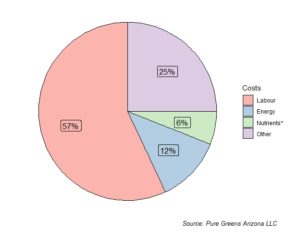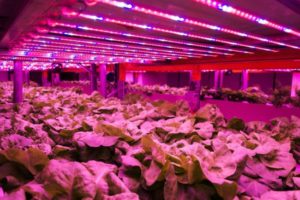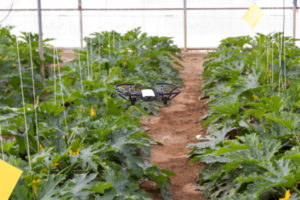
With an estimated 9.7 billion people on earth by 2050, food security will become a real concern for many countries around the world. Vertical farming is often regarded as a solution to our food scarcity issues due to its many advantages which I described in this article. Although vertical farming is becoming more popular, there are some red flags. It has high upfront costs, requires large amounts of energy, and requires a highly trained workforce.
This article explores all the disadvantages of vertical farming while suggesting possible solutions, as well.
Disadvantages of Vertical Farming
1. High initial costs
Vertical farming is a cost-intensive endeavor, as every step of the process from finding the right facilities to choosing the best-performing crops requires a substantial amount of money. Land prices alone greatly increase the initial upfront costs, as land in urban areas is usually very expensive. However, many vertical farms have been able to minimize facility-related costs by using existing structures, such as shipping containers, old factories, and abandoned office buildings. Alternatively, vertical farms could be built in barren land unsuited to conventional agriculture.
In many vertical farming startups, equipment costs put additional pressure on the budget. Most vertical farms need expensive equipment such as climate controls, shelving units, LED lights, water lines, computers, etc. Nevertheless, the cost of indoor agriculture equipment is expected to drop dramatically as indoor agriculture becomes more popular and the number of vertical farms increases.
2. High operational costs

Energy
Vertical farming is undoubtedly an energy-intensive endeavor, but even more so if farms rely solely on artificial lighting systems. Approximately 40 to 50% of the total production costs come from energy consumption and lighting costs alone can account for 25-30% of the operational costs.
Labor
For all indoor farming operations, labor is usually the highest operational cost, as it is estimated that a small hydroponic farm spends on average 57% on labor. Vertical farming is also expected to experience a significant reduction in operating costs as technology advances and becomes more efficient.
Other
Operating costs for most vertical farms depend largely on the farming method employed, as each has its requirements. Geoponic, hydroponic, and aeroponic methods are currently among the most widely used in vertical farming. For example, geoponic systems are less costly in terms of maintenance, labor, and technical costs, whereas, hydroponic and aeroponic methods, on the other hand, require highly skilled workers to function effectively. Aside from this, the costs of seeds, nutrients, and growing mediums in these systems add to the final operating costs. Small hydroponic farms spend, on average, 6% of their total operating expenses on seeds, growth media, and nutrients, while large ones spend, on average, 13%, according to Pure Greens Arizona LLC.

Shop The Farmstand – Self-Watering, Self-Fertilizing Solution for an Easy to Grow Harvest
3. A limited number of crops that can be grown economically
A vertical farm can be customized to support the growth of any plant species, however, only a limited number of them can be grown economically. In the global vertical farming industry, leafy greens and herbs remain the primary crop due to their rapid growth cycle, high cost, and short shelf life. Along with their relatively easy growing process, leafy greens have a high-profit margin that makes them very appealing to vertical farmers.
However, the popularity of vertical farming has led many to expand their cultivation repertoire by starting to grow more challenging crops like strawberries and tomatoes. For instance, the New Jersey-based vertical farm “Oishii” by reproducing the climate conditions of Japanese mountains indoors supplies New Yorkers with vertically grown strawberries of the rare Omakase variety.
In the near future, the use of cutting-edge technologies like Artificial Intelligence (AI) and Machine Learning (ML) should enable vertical farming to produce cheaper crops with a long shelf life, like grains. With the present technology, this may not be economically feasible just yet.
4. Crops that are currently grown have a small caloric density
Calorie density measures how many calories a food contains in relation to its mass or volume. At present, crops grown in vertical farms have a very low caloric density. For example, 100g serving of lettuce and spinach contains just 15 and 23 calories, respectively. By contrast, the British National Health Service (NHS) recommends 2500 calories per day for men and 2000 for women. Thus, vertically produced food only accounts for a small proportion of daily calorie intake proving that in the current state of cultivation vertical farming cannot meet all the nutritional needs of an adult human.
5. Very high demand for energy
Natural light in vertical farming is replaced by artificial illumination provided by LED (Light Emitting Diode) lighting systems. Depending on the needs of the plant species, the lights can be on for 12- 16 hours and in some cases even up to 20 hours per day. Lighting is the most critical component of a vertical farm, and it consumes large amounts of energy. A German study analyzing the economics of vertical farming estimated a 37-floor vertical farm would consume 3.5GWh of energy annually. In addition to increasing production costs, this substantial energy consumption also increases the carbon footprint and carbon emissions.
Vertical farming can drastically reduce its carbon footprint by gradually shifting toward renewable energy sources, such as wind and solar power. Various vertical farms are rapidly replacing traditional energy sources with renewables and some of them such as “Harvest London” are now entirely powered by renewable energy. As renewable energy becomes more prevalent in many countries, switching to it will be easier than ever. Furthermore, technological advances in the LED and HVAC systems will reduce both equipment and production costs as well as energy consumption.
6. Running a vertical farm requires sophisticated skills
Running a vertical farm is not an easy job as it requires advanced technological and horticultural skills that only a small percentage of people around the world possess. Due to the high tech involved in every stage of the production process, highly educated and trained individuals are needed to set up, run, and maintain a vertical farm.
For example, automation engineers and software engineers are required to install the climate stations, lighting system, and water recycling system. In addition, horticulturists and biologists are needed to select the best-performing crops and monitor each stage of plant growth, as well as maintenance engineers to ensure that every piece of equipment functions properly.
The availability of open-source materials online is helping to spread knowledge, enabling everyone interested to learn new skills. Furthermore, various vertical farming conferences are held annually, allowing people in the field to exchange their knowledge and experience with each other and newcomers. The introduction of vertical farming to the school system would also increase awareness in the younger generation and remove misconceptions and myths regarding the sector. The involvement of AI and ML in vertical farming will make this industry more attractive to younger generations, thereby revitalizing and boosting innovation in the aging farming industry.
7. The knowledge about indoor farming is still small
The concept of vertical farming was introduced in 1999 by Dr. Despommier and his graduate students and since its inception, vertical farming has rapidly become a global phenomenon. More countries are embracing vertical farming as a way to address global food security, driving an increase in the number of vertical farms around the world.
Even as vertical farming technology and production techniques continue to improve, a lack of knowledge still lingers in the industry. Highly trained professionals such as horticulturists and agriculture engineers, gain most of their skills through exposure to information and technologies associated with outdoor farming, thus creating a knowledge gap regarding newer approaches such as vertical farming.
Various vertical farms are reported to be losing money due to this lack of knowledge. For instance, supplying indoor systems with CO2, an essential component in the process of photosynthesis is crucial to ensure optimal plant growth, however, only a limited number of growers were aware of this. The confusion for many growers stems from the fact that outdoor farmers do not provide CO2 to their crops.
In order to fill this knowledge gap, extensive research is essential for vertical farming. In the fast-developing sciences of biotechnology and nutrition, controlled growing conditions and year-round production provided by vertical farms may be useful in getting a better understanding of the physiological, nutritional, and molecular processes of vertically grown crops.
Initiatives such as “Upstart University” are already offering online training courses about various techniques utilized in vertical farming such as hydroponics and aquaponics. Moreover, by providing these online training courses to agriculture students, they will not only gain a better understanding of the industry but also be more inclined to pursue it.
8. Pollination is more difficult
Pollination entails the transfer of pollen from the another of one flower to the stigma of another resulting in fertilization and the production of seeds and fruits. The pollination process in outdoor farming is carried out by bees, birds, wind, and other natural pollinators. The absence of these pollinators in vertical farming represents a major challenge that if not addressed could result in substantial economic losses. Poor pollination rates often result in poor fruit sets and the production of small and misshapen fruits. While hand-pollinating crops is an effective way of solving this problem in small farms, it can quickly become a hassle for vertical farms that span millions of square meters.
In order to solve this problem, various companies have developed innovative methods that can be applied to any vertical farm, regardless of its size. The US-based “Polybee” has developed small drones called pilots that can fly from flower to flower and pollinate them. The technology is currently used for pollinating vertically grown crops like tomatoes, peppers, and eggplants. Furthermore, an Israeli company ‘Edete‘ has developed an automated laser that can locate almond flowers and blow pollen into them. Currently, this technology is only used in outdoor farming, but it shows great promise for future use in vertical farming as well.

9. High dependence on technology working correctly
A typical vertical farm relies on technology to ensure the smooth operation of critical systems, such as temperature, lighting, irrigation, and humidity. Vertical farming’s reliance on technology also makes it susceptible to unpredicted events as even the most sophisticated equipment and software can suffer from malfunctions and glitches.
For instance, the occurrence of power outages even for a short period can result in catastrophic losses if not addressed immediately. Power outages can be fatal for plants because irrigation is usually done by pumps that operate on power and without power, they won’t be able to bring water with nutrients to the roots. And since there is no soil serving as a buffer, the plant can dry out really quickly.
Having maintenance engineers on staff can help vertical farms avoid technical problems and ensure all equipment is functioning properly and that problems are identified before they arise. Moreover, having a backup power system that is activated when the primary source of energy fails can help to avoid damages.
